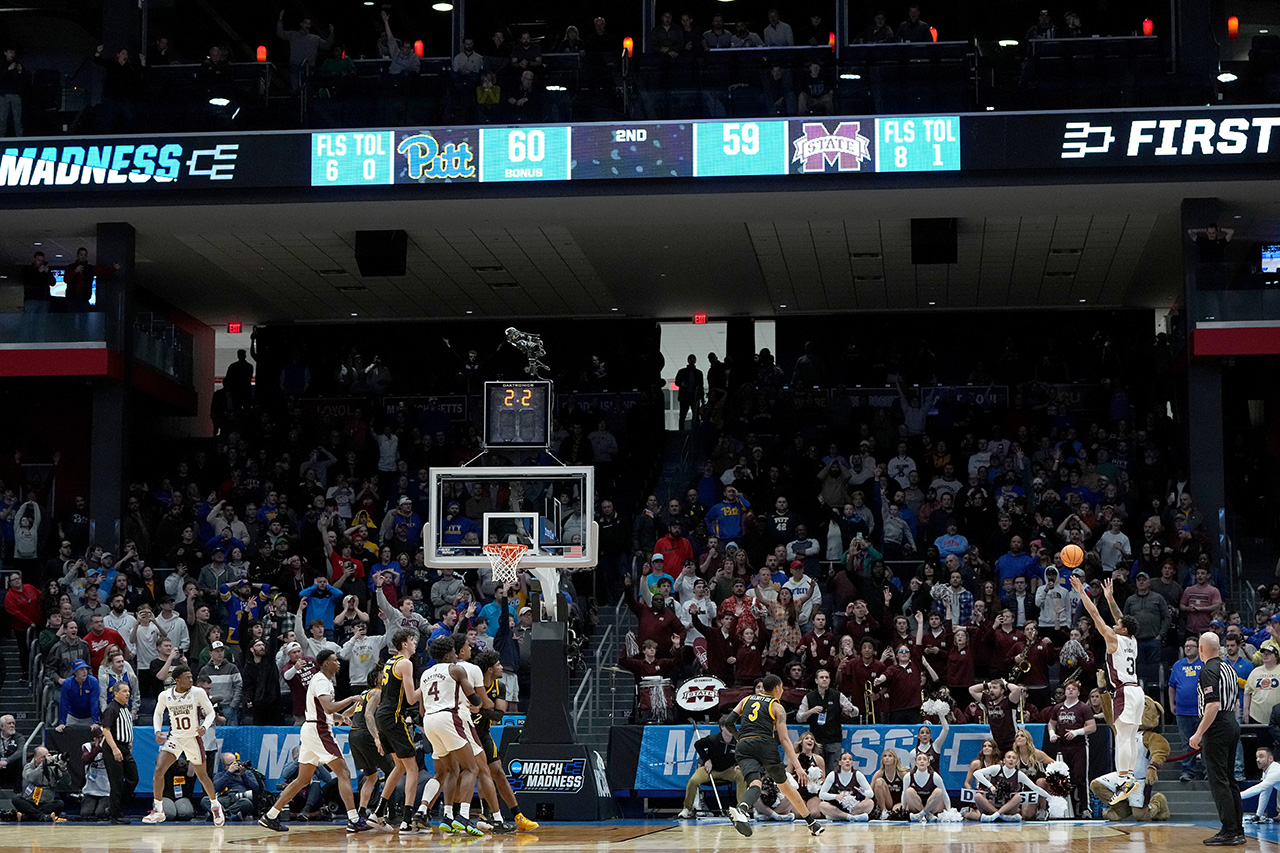Two games into the NCAA men's tournament, and already: Heartbreak. Pitt and Mississippi State, two of the at-large seeds competing in a play-in game for a spot in the field of 64, played a tremendously entertaining game Tuesday night. The biggest lead by either team was just six points, and basically everyone was involved offensively, with seven players scoring in double figures. When Pitt went on a little run near the end of the game, the Bulldogs came right back. They were down one with 2.7 seconds left. Then this happened.
That’s as good of a look as any team is going to get from three-point range on an inbounds play with three seconds to go. It is, I would say, about as good of a look a team is going to get on a three at any point in the game. Shakeel Moore still wasn’t really all that close on it, but D.J. Jeffries had a great shot at tipping the ball in for the game-winner, and that one just missed. The Panthers held on for a 60-59 win.
There is a lot more of this coming in the tournament. Moore got a great look, and the shot simply didn’t go down. It was a rough finish. But it is funny—to me, at least—that the Bulldogs drew up a play that ended up in a three-point attempt, down one, with three seconds left. As you may know from Lauren Theisen’s blog last year on announcers saying “you don’t need a three,” announcers never think teams Need A Three Here. Over the weekend I heard an announcer say that a team down 6 with about 10 seconds left didn’t need to shoot a three. In the opening game of the tournament, a matchup of auto-qualifiers Southeast Missouri State and Texas A&M-Corpus Christi, SEMO’s Phillip Russell hit a layup to cut the deficit to a point with 15 seconds left. Sideline reporter Jon Rothstein—he’s wilder than a goat rodeo—had a comment after watching the team’s huddle after the ensuing timeout: Southeast Missouri coach Brad Thorn “was thrilled with his team’s decision not to settle for a three.”
I think this kind of attitude made way more sense when teams did not utilize the three-point shot the way they do now. But three-point shooting has spiked in college just as it has in the pros, and all of Division I now shoots about 10,000 more threes than it did at the start of the century. In 2000, 30 percent of shots came from distance. This season 37.3 percent of shots were threes. It’s not that teams shoot any better, to be clear: The NCAA keeps moving the line back, and the 2019-20 season had the lowest percentage ever as a result. But with so many more three-point attempts, there’s a much greater chance the opposing team will come down and hit a three right after the other team judiciously settled for a two.
But maybe a team is in a fouling situation, and that scenario does not apply. That SEMO Missouri layup came with 15 seconds left; they would be fouling on the other end. Great. The issue, in their case, is that Texas A&M-CC is currently second in the nation in free throw percentage at 80 percent. The guy the Redhawks fouled, Jalen Jackson, shoots 70 percent from the line, and made them both. Which means Southeast Missouri gave away a few seconds, found itself down three anyway, and then ended up missing a three with two seconds left. The Islanders won, 75-71. Despite my initial reservations, I could go either way on this one—plus, SEMO’s layup to cut it to a point was pretty easy. They really didn’t need a three; maybe i just wish announcers would stop saying it.
The Mississippi State play was fine. They got a great look. And the three-pointer was one of the last options. “There were multiple looks on that play,” Bulldogs coach Chris Jans said. “I think maybe we have run it one time all year long, and there were a couple lob options early.” Inbounder DaShawn Davis saw a guy super wide open, and just had to pass it to him. “It was really simple,” he said.
How’d he miss a shot that wide open? Pitt coach Jeff Capel said the Panthers fans in attendance willed the ball out of the bucket. “Throughout the game, you heard the ‘Let’s go Pitt!’ chants,” he said. “And then at the end when we blocked that shot in those last 2.7 seconds, I thought their energy helped that ball not go in, the three in the corner and then the tip-in.”
He was there and I wasn't, so he might be right. But there was another wrinkle: Mississippi State is literally the worst three-point shooting team in the country at 26.6 percent. Moore himself shoots 26 percent from distance. They got a wide open shot; Jans's play worked. It just didn't work out. It won't make it any less heartbreaking for Mississippi State or its fans, but there was something gratifying about the fact that finally, after all those mindless reruns of the phrase, they really didn’t need a three there.






